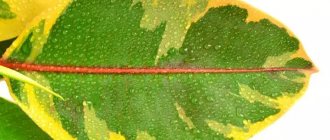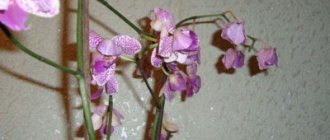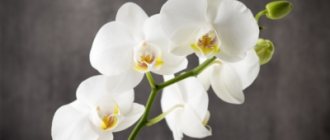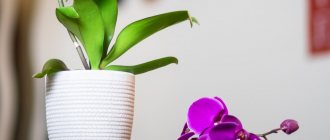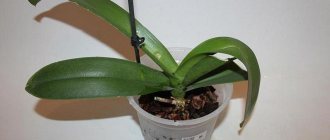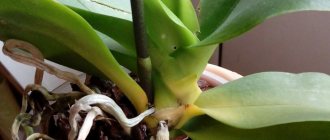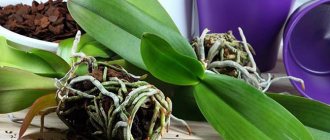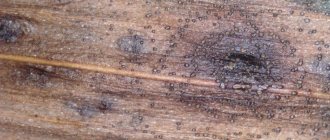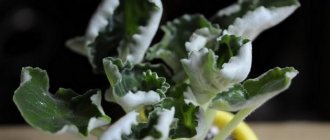Pulling the flower by the stem
The most common mistake when replanting is trying to pull parts of the plant when removing it from a purchased container. You need to carefully pry off the flower using available tools. If necessary, you can tap on the bottom, but it is strictly forbidden to pull on the stem.
After removing the plant, you need to clean the root a little. This will help speed up growth. After this, soil is poured into a new pot, the plant is placed there and soil is added on top. Then water the flower.
How to transplant “female happiness”: basic rules
Factors such as:
- Incorrect period for the procedure . You cannot replant a flower during flowering, when all its strength is almost gone. Without inflorescences, the flower will overcome the “moving” to a new place much easier.
- Changing soil too frequently . The soil should be updated no more than once every 3-4 years. The best time for this is the beginning of spring, but after the flowering process is completed.
- The plant is not 3 years old . The young spathiphyllum has not yet strengthened its immunity, so any mistake in care or infection can destroy it.
In addition, the transplant must take place using a certain technology:
- Moisten the soil in a bowl.
- Remove the flower.
- Free the roots from the soil.
- Cut off the rotten areas and remove the flower stalks so that the flower does not waste energy on them, and sprinkle the cut areas with crushed activated carbon.
- Fill a new pot with a 2 cm thick drainage layer and add a small amount of soil.
- Place the flower in a container, cover it with the rest of the soil and lightly press it down on top so that the plant does not dangle.
- Water the soil, moisten the leaves with a spray bottle, cover with cellophane to create a greenhouse effect.
- Place the plant in a warm room and provide it with diffused lighting.
Important! Before planting, the soil must be disinfected by heating it in the oven at 200 degrees or placing it in the freezer for several hours.
Replanting a plant is a real shock for him. But if you cannot do without it, then it is necessary to carry out the procedure according to all the rules. It is equally important to choose the right time, and also take into account the age of the plant and its readiness to flower.
Immediately after transplanting, expose the plant to the sun.
After the transplant is done, it is important to carefully care for the plant. Do not expose the flower to the sun for several days. Excessive ultraviolet radiation can greatly harm the plant.
It is also important not to flood the soil. It should not be too damp, but only slightly damp. If the leaves begin to droop, increase the amount of water. When they turn yellow, they are reduced.
Caring for a houseplant is a simple process. You just need to follow some rules. Then the flower will delight you with its beauty for a long time.
Why spathiphyllum dropped its leaves
There may be several reasons. Before you do anything, you need to figure out why the flower of female happiness has withered.
Has your spathiphyllum dropped its leaves after replanting?
Yes
52.79%
No
47.21%
Improper watering
Most often, spathiphyllum leaves droop due to watering errors. They can wilt due to either excess or lack of moisture.
Overwatering is more dangerous:
- water stagnates;
- the soil in the pot turns sour;
- the plant stops absorbing oxygen and nutrients;
- The root and base of the rosette are rotting.
Spathiphyllum leaves wither from excess moisture not only when watering heavily, but also when they forget to put drainage in the bottom of the pot; there are no lower holes, or they are clogged.
If a flower has drooped its leaves because the substrate has dried out, and this is noticed in time, it is not difficult to revive the plant. Some owners are so afraid of waterlogging that they don’t even water the spathiphyllum until the plates droop.
But for women’s happiness this is stress, and it will definitely have consequences. A plant subjected to regular drying is weak, develops poorly and refuses to bloom.
Transfer
The second place after watering errors is replanting, and not necessarily the wrong one:
- The bush was divided. After surgery, even a healthy spathiphyllum may drop its leaves for several days.
- Rosettes devoid of lower shoots were planted into the substrate.
- The rotting rhizomes were cleaned up.
- Dividing a bush without trimming flower stalks.
- Improper or contaminated soil.
- To make the leaves fall, it is enough to plant a small spathiphyllum in a very large container.
- Severe deepening of the rosette will not only lead to the appearance of fading vegetative organs. If the situation is not corrected, they will turn yellow and begin to rot.
The plant may lower its plates because it has not been replanted for a long time:
- The root has occupied the entire volume of the container; water and nutrients do not remain in the pot. And they are not absorbed.
- The earth has deteriorated: it has become sour or salty. Both will make women's happiness drop its leaves.
- The bush has grown and become too large and dense. Part of the rhizome has grown old and shriveled, the plates inside the clump do not receive enough light, even young ones turn yellow and become lethargic.
Care errors
Other reasons why spathiphyllum leaves droop:
- critical shortage of nutrients, for example, lack of fertilizing when the plant has not been replanted for several years;
- the root froze - this usually happens when the spathiphyllum stands on a cold windowsill in winter;
- during normal irrigation of the bush, water is poured not along the edge of the pot, but into the outlet;
- excess nitrogen fertilizers;
- frequent spraying of the above-ground parts during the dormant period when kept cool;
- spathiphyllum stands on a south window without protection from the scorching sun;
- the air is too dry, in this case, drooping leaves usually have dry tips;
- the plant will lower the plates, receiving a burn to the roots when applying fertilizers without first moistening the substrate;
- the flower hung its greenery due to drafts;
- In winter, the pot stands next to a radiator or other heating device.
Diseases and pests
If spathiphyllum has pests, leaves usually do not drop. Unless the insects have already “finished” the flower and drank all the juices from it.
When a woman's happiness is sick, she will definitely lower the plates due to rot, fusarium, late blight, and bacteriosis. When affected by sooty fungus, photosynthesis must stop for the vegetative organs to wilt.
Prevention
Of course, to avoid such problems, spathiphyllum should be protected from the influence of external factors. Therefore, it is recommended to keep the flower in greenhouse conditions for a couple of weeks. That is, create a mini greenhouse, or simply cover the plant with a plastic bag. There, maintain a temperature of +23-25°C and high humidity. Carry out regular watering as needed, and do not forget to ventilate the greenhouse daily. After a while, the flower can be moved to its place and continued to be grown under the same conditions.
If after the transplant you adhere to the above recommendations, then you will not have to study the symptoms and take measures to treat the indoor exotic. Take care of your pet during a difficult time for him, and he will respond with lush, long-lasting flowering.
The seedlings became covered in spots after planting
The appearance of spots of different colors and shapes on the leaves of transplanted seedlings can indicate three things at once. Firstly, this is how a lack of nutrients is expressed. Brown spots indicate a lack of potassium, blue-green spots indicate a lack of phosphorus, and red spots indicate a lack of nitrogen. Secondly, some insects leave such traces. For example, the tomato rust mite shows its presence with brown spots on the leaves, the onion secretive proboscis, tobacco whitefly, soldier bug and melon aphid - yellow, California thrips - silver. And finally, the spots can be burns left by drops of water falling on the leaves. This happens if you water the seedlings not at the roots on a sunny day.
What to do : carefully inspect the plantings for pests. If no signs of their presence are detected, carry out corrective feeding with the missing nutrient. If insects are found, take action.
The seedlings changed color after planting
But a change in the color of leaves and stems in seedlings is a dangerous sign. Violet, red, gray and brown shades should alert the gardener. Thus, plants are literally screaming about an acute lack of certain nutrients in the soil. Most often they are deficient in phosphorus, potassium or nitrogen, but they may also be deficient in boron or iron.
- Nitrogen, phosphorus, potassium - signs of deficiency and excess in plants
What do excess or deficiency of nitrogen, phosphorus and potassium lead to? Find out in our infographic!
What is yellowing?
First, the tips of the leaves turn yellow , and if the reasons why this happens have completely affected the spathiphyllum, then the pale yellowness will spread to the entire leaf blade. It may also be that brown spots appear on the leaves, after which the stems begin to wither, turn yellow and dry out.
In the photo you can see the yellowed parts of the flower.
Incorrect conditions of detention
The cause of the development of the disease may be improper plant maintenance conditions. Spathiphyllum loves the sun, but not scorching rays. As a permanent place of residence, it is best to choose window sills on the east or west side.
Low humidity levels can also cause illness. If the plant is very wilted, use a household humidifier or regularly spray it with warm water.
After transplantation, the flower is placed in greenhouse conditions for several weeks. To do this, organize a mini-greenhouse or cover it with a plastic bag.
The greenhouse maintains optimal temperature (+23. +25°C) and humidity level (50–70%). Ventilation and regular watering are provided.
Setting the stage
What should the soil be like for replanting? The ideal option is soil with a slightly acidic reaction. You can purchase the required soil for replanting in specialized stores. A mixture suitable for aroid species or flowering tropical varieties. The purchased composition must be mixed with sand in a small amount. Suitable primer can also be made independently. For this you will need leaf soil, turf soil, peat, charcoal, crushed brick, coarse sand in proportions 1:2:1:0.5:0.5:1. If you don't have charcoal, you can replace it with crushed tree bark or coconut fiber. To enrich the soil with useful elements, superphosphate is added. The use of other additives is allowed, but their amount should not exceed 10% of the total composition. Otherwise, there will be problems with ventilation, as well as soil moisture capacity.

